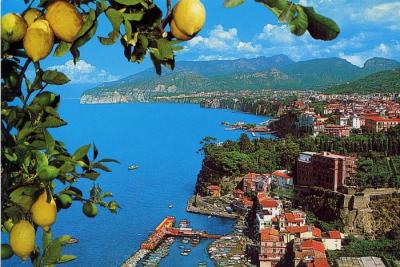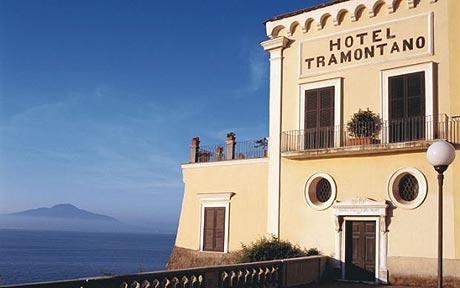Sorrento: seductive gateway to the south

SORRENTO -- Naples has long been a leading tourist destination not only for the city itself but for the choice places nearby such as Capri, the Amalfi coast, Ravello, Paestum and Pompeii. But Naples’ garbage disposal crisis and the widespread petty crime have dissuaded all but the hardiest from visiting it. ‘See Naples and die,’ a tribute to its beauty, has taken on sinister connotations.
Sorrento is the solution. Sitting atop 50 metre high sandstone cliffs similar to the entrance to Sydney harbour, the elegant resort town is only 30 miles (47 km) from Naples, which can be reached by ferry, car and rail. The Circumvesuviana railway (Sorrrento-Naples) stops at both Pompeii and another remarkable archaeological site Herculaneum. Pompeii is closer to Sorrento than to Naples and Herculaneum is about midway.
The railway does not clog up as the road sometimes does. Sorrento is a great hopping-off point. Capri is much closer than it is to Naples, it is only 15 kilometers to Positano and the spectacular Amalfi coast, and another 50 takes one to the honey-coloured Greek temples of Paestum. It has avoided the defects of afflicted Naples -- it is clean, without accumulated garbage in its streets, and has little crime.
It has recognised that it needs to keep that way to preserve its tourist trade during a recession. Urban regulations have curbed the indiscriminate building which ruins much of southern Italy -- lemon tree plantations, whose plants soar over four metres and give three crops yearly, still abut the town’s streets where orange trees flower and fruit. Sorrento's handsome hotels testify to its proud tourist tradition.
A prime example of that tradition, the Tramontano, on the site where the 16th century poet Torquato Tasso was born, has had guests ranging from the poets Byron and Shelley, Henrik Ibsen, who wrote his play Ghosts here, Mark Twain and James Fenimore Cooper to present day-celebrities such as the Russian tycoon Roman Abramovich and the 007 actor Pierce Brosnan.
In the 1870s the Czarina of Russia, Maria Alexandrovna, with a retinue of 200, stayed at the Tramontano for just over six weeks; the famous song Torna a Surriento (the dialect word for Sorrento), composed at the hotel, was performed to persuade her to return.
Another renowned hotel, the Excelsior Vittoria, has also hosted counted celebrities including Richard Wagner who had his final quarrel here with another Sorrento enthusiast, Fredrich Nietzche. As has been the case since the 19th century, English visitors are the most numerous in Sorrento, perhaps still influenced by the contacts made here by British and Commonwealth troops during the second world war, but Russians are playing an increasing role. What do they find that has made Sorrento the fourth choice for Italy in the 2012 Trip Advisor after Rome, Venice and Florence? (Naples does not even figure in the list.)
A clean town in a setting which has led to more than 100 films being made in the Sorrento peninsula, good weather except in August, and good restaurants with two outstanding -- the elegant Il Buco, by the Town Hall, which has a renowned chef Giuseppe Aversa, and La Favorita ‘O Parrucchiano, founded in 1868, which claims to have invented the cannelloni pasta dish. Not only is the food tasty but the restaurant nestles in a luxurious garden. A key to Sorrento’s continued appeal is that it has renewed its traditions such as the creation of Christmas cribs which range from the minute to works of art of huge dimensions.
Another tradition is wood inlay work which once flourished in places such as Nice, Florence and Tunbridge Wells but is now preserved principally in Sorrento where a school and workshop open to the public have been established and a local architect has founded the world’s only museum of marquetry. The museum also chronicles Sorrento history, displaying among other things huge photos of renowned visitors such as Charles Dickens, Norman Douglas, Herman Melville, F.Marion Crawford, Henry James, and Maxim Gorky. Gore Vidal who had a house further down the coast at Ravello, said of Norman Douglas that he “personified like some mad Scot Pan the spirit of this Siren land.” Giacomo Casanova visited Sorrento but that was before the invention of photography.
At the Correale Palace, sculpture, paintings, furniture, clocks and ceramics of the former owners are displayed. The Correale family, princes of Terranova, was prominent during the centuries of Spanish Bourbon domination of southern Italy which ended in 1860. The Spanish influence is still evident during the dramatic Holy Week ceremonies and processions. But long before that the coastline hereabouts was lined with magnificent villas of ancient Roman aristocrats and hard -core rich. Some were members of the court of the emperor Tiberius who, in his last years, ruled from Capri.
The court member knew that, to stay in the emperor’s good books, they should not be too far from him but feared being too close on Capri in case he assigned them to the book of the dead. In the grounds of Villa Fondi, which has a top-class museum of local archaeological finds in Piano di Sorrento, is a ruin of an imperial villa where the ancient Roman paintings of vegetation and birds are still a bright blue. Nearby the tiered remains of an extensive 1st century AD villa can be visited. The remains of the villa of the adopted son of Emperor Augustus are beneath the Bellevue Syrene hotel in Sorrento.
There are 18 small communities in the Mass Lubrense zone, each with a church and a coffee bar. The population fled to these hillside sites when Muslim marauders from North Africa, the Saracens, raided the coastal settlement in 1556, killing 2000 and taking prisoners, some of whom were eventually ransomed. The Saracens raided Sorrento itself in the same period. Watch towers, some of which still stand, were then built along the coast to give early warning of other attacks.
The balmy climate favours relaxation but for energetic visitors this is a walking zone with well-marked paths, some of which lead up to the ridge above the Sorrentino peninsula overlooking both the gulf of Naples and that of Salerno to the south with Mount Vesuvius towering above both. It is also a good area for scuba diving: at Punta Campanella there is a marine protected zone of over 1000 hectares.
“Vesuvius is our fortune” said one Sorrento waiter, referring to the fertile Sorrento plain formed by volcanic action an estimated 35,000 years ago. The huge lemon and orange trees are a result: in Sant’Agnello one can visit Il Pizzo citrus plantation with 15,000 trees cultivated by the same six families since 1860. The Jesuits, as well as the volcanic soil, are responsible for the famous fruit here because in the 17th century they showed locals how to protect plants against cold weather which enabled production beyond their normal habitat in Calabria and Sicily. Now lemon trees are favoured as they are more prolific than orange plants and the fruit, like golden full moons, is better paid. Lemons are also the basis of the local liqueur limoncello now known worldwide.
But orange blossom is still in plentiful supply for the marriages of visitors which have become a standby of the Sorrento tourist trade. The mountains are as productive as the plains. Partly due to geographic and climatic conditions Gragnano, 10 miles (13 km) from Sorrento, makes some of Italy’s best pasta. Fine white wines are produced locally and an imaginative variety of cheeses, often enhanced by aromatic herbs. One tradition which is struggling to survive is fishing. Fisherman complain that stringent European Union regulations are applied to them but not to competing North African and Japanese fishing boats.
“It is easier to land a kilo of cocaine than a kilo of tuna” one fisherman complained. To tackle the problems by eliminating middle men, the fishermen are to open an eatery at the Grande Marina, a port village within Sorrento, where they will serve their own catches.
Information site: Sorrento Tourism.com



